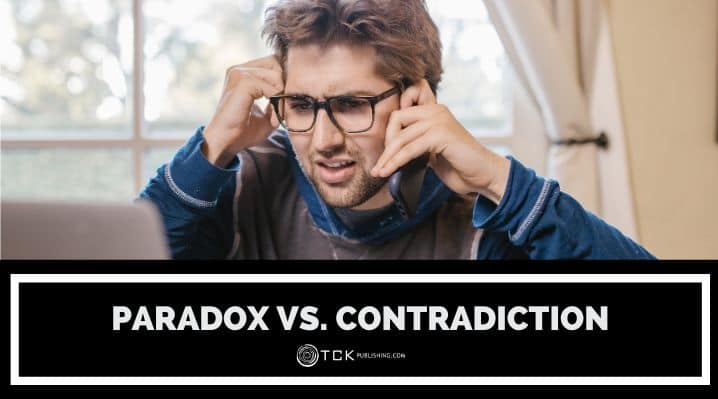
Many people use the terms “paradox” and “contradiction” interchangeably. On the surface, they look similar—both involve opposing ideas. But when you dig deeper, you’ll see they serve entirely different purposes, especially in storytelling.
What Is a Paradox?
A paradox is a statement that seems self-contradictory but, on closer inspection, reveals a deeper truth. Paradoxes can be thought-provoking and poetic. They challenge readers to think beyond the obvious.
Examples:
- Less is more.
- George Orwell’s Animal Farm: “All animals are equal, but some animals are more equal than others.”
- Oscar Wilde’s The Picture of Dorian Gray: “The only way to get rid of a temptation is to yield to it.”
- Schrödinger’s cat: A cat in a box is both alive and dead until observed.
- The Fermi Paradox: There is a high probability of extraterrestrial life in the universe. However, there is a severe lack of evidence or contact with such life.
Unlike contradictions, paradoxes don’t break logic—they stretch it.
In Writing
Paradoxes make readers pause and reflect. They work on two levels:
- The reader comes upon a statement that seems wrong.
- The reader is encouraged to look deeper, finding the truth within the statement.
A good paradox can also sum up a story’s message. It’s a great way to draw your reader’s attention to a specific line. This way, you create moments of realization that will linger in their minds long after they’ve read your work.
Characters with paradoxical traits can also be fascinating. Think of a ruthless villain who does evil for what they believe is the greater good.
What Is a Contradiction?
A contradiction happens when two statements or ideas directly oppose each other and cannot logically coexist. It’s like saying, “I’m both awake and asleep at the same time.” That just doesn’t make sense!
Examples:
- A society that values peace but imposes violent laws to maintain that peace.
- Logical contradiction: “The cake is both completely eaten and not eaten at all.”
- Batman is a hero who operates outside the law but enforces justice.
- “The following sentence is true. The preceding sentence is false.”
- A wealthy philanthropist exploiting workers to fund their charity.
In Writing
You can use contradictions to make a point or inject humor into your work. They’re great when writing satire. You can expose hypocrisy or double standards while making sure your audience is paying attention.
Contradictions also make characters realistic. Nobody is 100% consistent. The inconsistency between a character’s actions and values can lead to interesting tension.
Imagine a pacifist who resorts to violence when provoked. How does such a character reconcile their views with their actions? These struggles make them believable and relatable.
Quick Comparison
While both create tension, contradictions are outright clashes, while paradoxes are more nuanced.
| Contradiction | Paradox | |
|---|---|---|
| Definition | Two opposing ideas that cannot coexist. | An idea that seems contradictory but holds truth. |
| Purpose | Highlights flaws or inconsistencies. | Encourages deeper reflection. |
| Example | “She is dead and alive at the same time.” | “She lives on in the hearts of others.” |
Practical Tips for Writers
Both paradox and contradiction are great additions to your toolbox. But like every tool, you need to know how to use them.
Don’t overuse them.
A well-placed paradox or contradiction can enhance your writing, but too many will feel forced or artificial. Use them sparingly for maximum impact.
Use contradictions to create inconsistencies.
Contradictions can reveal flaws, hypocrisy, or inner conflict in characters. For example, a character who preaches selflessness but always acts selfishly. This creates natural tension that drives the story forward.
These inconsistencies can be relatable. The more human your characters are, the more they resonate with your readers. For example, a parent who values family time but constantly overworks to provide for them.
Use paradoxes to provoke thought.
Paradoxes are excellent for making readers pause and reflect. They’re not just for revealing truths, but also exploring the nuances between complex themes like love, identity, and freedom. Such themes are universal and will latch deep into your readers’ emotions. Use them to reveal your story’s core ideas or add depth to dialogue.
Use contradictions to highlight moral ambiguity.
Characters with conflicting values can challenge readers’ preconceived notions about right and wrong. It makes these characters feel human and less predictable. Diving into these gray areas makes your stories more thought-provoking.
Anchor paradoxes in context.
A paradox works best when it aligns with the story’s tone and message. If it feels out of place, it can confuse the audience instead of intriguing them. Ensure your paradox serves the story’s bigger picture.
Let contradictions evolve.
Contradictions don’t need to be static. Characters and situations can start with contradictions that resolve or deepen over time.
A character’s hypocrisies might lead to growth or further moral decay. This evolution keeps readers engaged.
Pair paradoxes with powerful imagery.
A well-crafted paradox paired with vivid imagery can linger in the reader’s mind. For instance, a phoenix represents a paradox. It dies in flames yet is reborn from them, symbolizing the cyclical nature of life and death.
Related Concepts
Here are other concepts related to paradox and contradiction.
Oxymoron
Combines contradictory terms to create striking phrases (e.g., “bittersweet,” “jumbo shrimp,” “living dead”). Oxymorons are often used in poetry, prose, and even titles to evoke strong imagery.
Irony
A situation or statement where the outcome is contrary to what is expected (e.g., a fire station burning down). Irony adds humor, suspense, or poignancy to writing.
Juxtaposition
Placing two contrasting ideas side by side to highlight their differences (e.g., describing a peaceful garden amid a chaotic city). Juxtaposition is often used to create tension or enhance themes.
Doublethink
Coined by George Orwell in 1984, doublethink involves holding two contradictory beliefs simultaneously, such as “War is peace” or “Ignorance is strength.”
What’s your take on paradox vs contradiction? Share your thoughts below!
If you enjoyed this post, then you might also like:
- Analogy vs. Metaphor: What’s the Difference?
- Semantics vs Syntax: What’s the Difference?
- Hyperbaton vs. Anastrophe: What’s the Difference?
- Comparatives vs. Superlatives: Which Adjective Do You Need?

Cole is a blog writer and aspiring novelist. He has a degree in Communications and is an advocate of media and information literacy and responsible media practices. Aside from his interest in technology, crafts, and food, he’s also your typical science fiction and fantasy junkie, spending most of his free time reading through an ever-growing to-be-read list. It’s either that or procrastinating over actually writing his book. Wish him luck!
